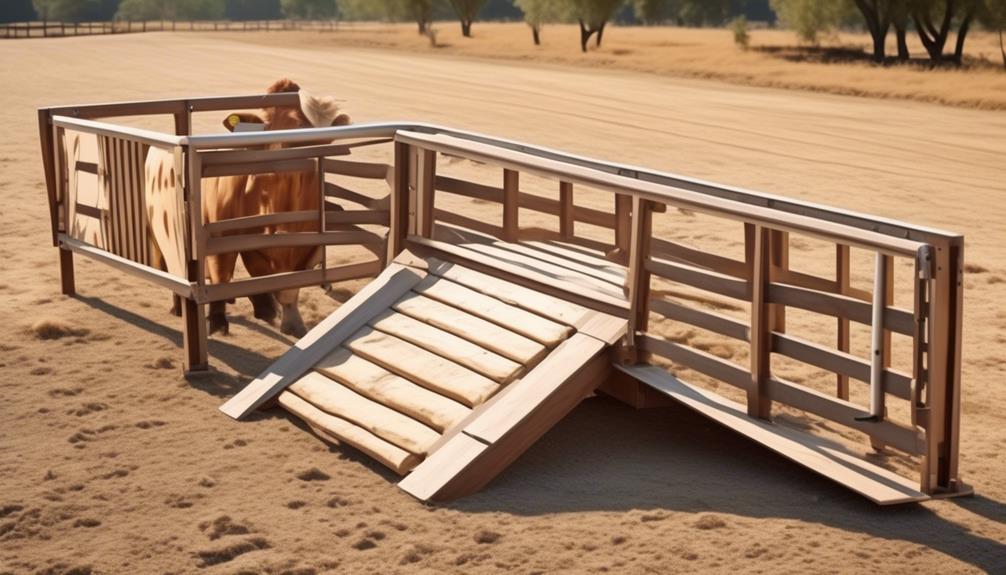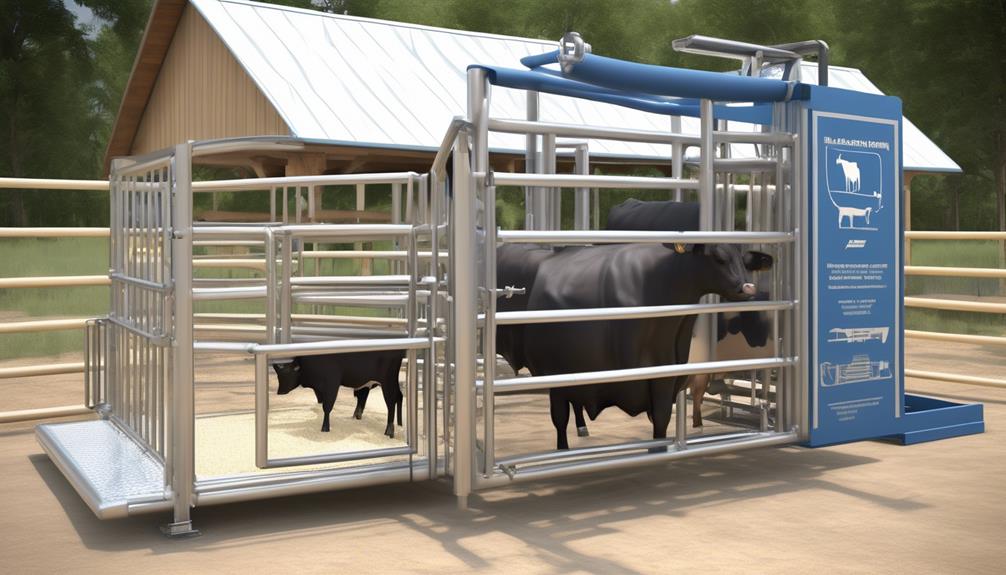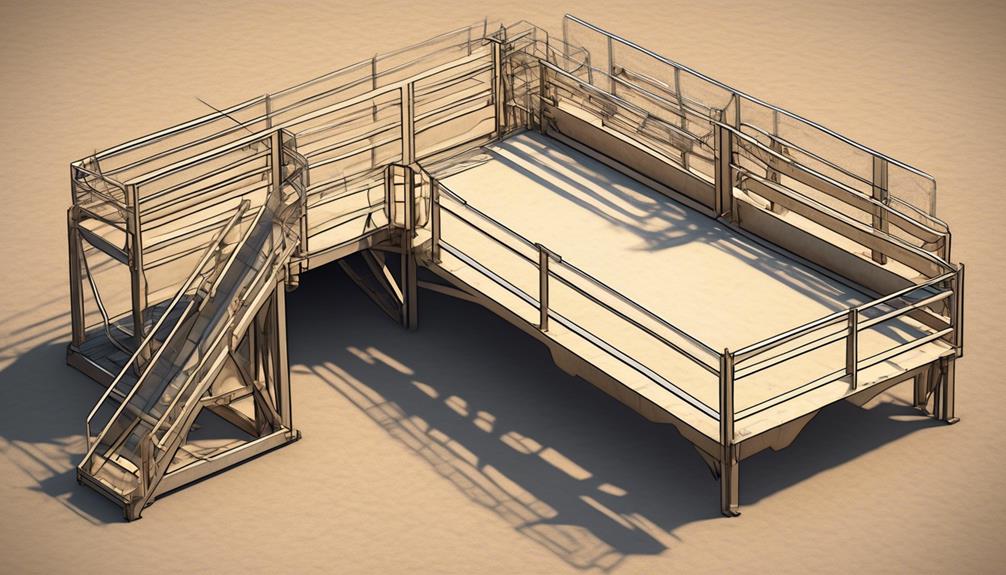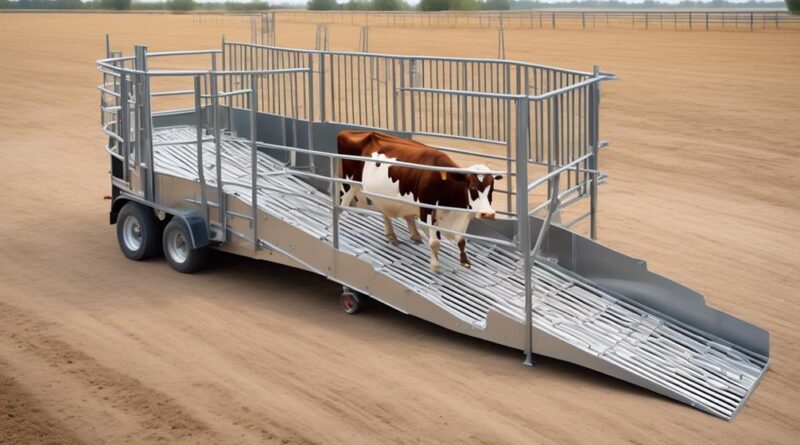9 Best Cattle Loading Ramp Plans for Efficient Cattle Handling
When it comes to handling cattle, having the right loading ramp can be the key to smooth operations. Picture this: you've got a herd of cattle that needs to be loaded onto a truck, and having a well-designed cattle loading ramp can make the entire process efficient and stress-free.
But with so many options out there, how do you know which plans will best suit your needs? Well, we've got you covered. Stick around to discover the top 9 cattle loading ramp plans that are designed to streamline your cattle handling process and make your life a whole lot easier.
Wooden Cattle Loading Ramp Design

Design a sturdy wooden cattle loading ramp to ensure safe and efficient cattle handling. When creating the design, prioritize ramp safety to prevent accidents and ensure the well-being of both the cattle and handlers. To achieve this, focus on using quality materials and construction techniques. Regular ramp maintenance is crucial to uphold its safety standards. Inspect the ramp frequently for any signs of wear and tear, such as loose boards or damaged surfaces, and promptly address any issues to prevent potential hazards.
For the wooden cattle loading ramp, select durable lumber that can withstand the weight of the cattle and the stress of regular use. Pressure-treated wood is an excellent choice as it offers resistance to decay and damage from the elements, prolonging the ramp's lifespan. Additionally, ensure that the ramp's surface provides ample traction to prevent slipping, especially for the cattle as they ascend and descend.
Incorporate safety features into the design, such as sturdy handrails and non-slip treads, to provide stability for both cattle and handlers. These measures contribute to ramp safety and reduce the risk of accidents during loading and unloading procedures.
Furthermore, establish a routine maintenance schedule for the wooden cattle loading ramp. Regularly inspect and clean the ramp to remove any debris or waste that could compromise its safety. Additionally, perform necessary repairs promptly to address any structural concerns.
Steel Cattle Ramp Construction
When constructing a steel cattle ramp, prioritize durability and safety by selecting high-quality materials that can withstand the weight and movement of the animals. Steel ramps offer several advantages over other materials, including durability, longevity, and low maintenance requirements.
The strength of steel provides a sturdy and reliable structure that can handle the pressure and weight of cattle, ensuring a safe and secure environment for both the animals and handlers. Additionally, steel ramps are resistant to weathering, corrosion, and pests, making them a long-term investment for efficient cattle handling.
To maintain a steel cattle ramp, it's essential to regularly inspect the structure for any signs of wear, corrosion, or damage. Addressing any issues promptly can help prolong the lifespan of the ramp and ensure the safety of the cattle during loading and unloading. Routine cleaning and applying protective coatings can also help prevent corrosion and maintain the structural integrity of the ramp.
Furthermore, it's important to keep the ramp surface free of debris and slippery substances to prevent accidents and ensure smooth cattle movement.
Portable Cattle Loading Ramp Ideas

To ensure efficient cattle handling, consider exploring portable cattle loading ramp ideas, which offer flexibility and mobility for transporting and managing livestock, building on the durability and safety principles of steel cattle ramp construction.
Portable ramps provide numerous advantages, including the ability to easily move the ramp to different locations on the farm, enabling you to adapt to changing cattle handling needs. This mobility allows for strategic positioning based on cattle behavior and grazing patterns, optimizing the flow of livestock during loading and unloading processes.
Additionally, portable cattle loading ramps are designed to be lightweight yet sturdy, making them easy to transport and set up as needed. This feature is particularly beneficial for temporary cattle handling sites or when working with leased grazing land. The portability of these ramps also supports efficient cattle handling techniques, such as low-stress livestock management. By being able to position the ramp in areas that minimize cattle stress and anxiety, you can significantly improve the overall handling process, reducing the risk of injuries to both the animals and handlers.
Furthermore, the adaptability of portable cattle loading ramps aligns with the principles of rotational grazing and herd management. You can relocate the ramp to facilitate strategic rotational grazing, allowing for efficient movement of cattle between grazing areas while ensuring proper land management. This flexibility contributes to improved overall herd health and productivity, ultimately benefiting both the cattle and the operation as a whole.
DIY Cattle Ramp Plans
Consider utilizing simple and durable materials to construct a cost-effective DIY cattle loading ramp for efficient livestock handling on your farm. When building your own cattle ramp, safety measures should be a top priority. To ensure the safety of both the cattle and handlers, the ramp should have non-slip surfaces, sturdy railings, and gradual inclines to prevent injuries and stress on the livestock.
Additionally, incorporating cost-effective materials into your DIY cattle ramp plans can help you save on expenses while still achieving a functional and durable structure.
One cost-effective material to consider for your cattle loading ramp is pressure-treated lumber. It's durable, readily available, and can withstand the weight of cattle. Another option is using recycled or reclaimed materials such as old steel pipes or sturdy wooden planks, which not only reduces costs but also promotes sustainability.
To further enhance safety, ensure that all fasteners and hardware used in the construction are of high quality and designed for heavy-duty applications. Investing in proper lighting for the ramp area can also contribute to safe cattle handling, especially during low-light conditions.
Adjustable Cattle Loading Chute Blueprint

You can create an adjustable cattle loading chute blueprint that allows for efficient and adaptable cattle handling on your farm. When designing the blueprint, consider incorporating adjustable chute features to enhance the functionality of your cattle loading system.
An adjustable chute provides the flexibility to accommodate different sizes of cattle, making the handling process more efficient and less stressful for both the animals and the handlers.
Efficient cattle handling is essential for smooth operations on your farm. An adjustable cattle loading chute can contribute significantly to achieving this efficiency. The ability to customize the chute according to the size and behavior of the cattle helps in streamlining the loading process.
By having an adjustable chute, you can easily adjust the width and height to create a comfortable and secure environment for the cattle as they move through the loading area.
Incorporating features such as adjustable side panels and gates allows you to control the flow of cattle during loading, reducing the risk of injuries and minimizing the time required for the process.
Additionally, an adjustable chute blueprint enables you to adapt to different handling requirements, ensuring that your cattle handling facilities are versatile and capable of meeting various needs.
Hydraulic Cattle Ramp System Layout
Designing a hydraulic cattle ramp system layout that integrates seamlessly with the adjustable chute blueprint enhances the efficiency and adaptability of your cattle handling facilities. When planning the layout for your hydraulic cattle ramp system, consider the following key aspects to ensure optimal performance and safety:
- Hydraulic System Advantages
- The hydraulic system offers smooth and precise control, allowing for gentle and stress-free cattle handling.
- It provides the ability to adjust the ramp height and slope, catering to different cattle sizes and breeds.
- The hydraulic system ensures quick and efficient loading and unloading of cattle, saving time and labor.
- Installation Process
- Ensure that the hydraulic system is installed by experienced professionals to guarantee proper functionality and safety.
- Regularly inspect the hydraulic components and connections to identify any potential issues and prevent downtime during cattle handling operations.
- Safety Features and Maintenance Requirements
- Incorporate safety features such as non-slip flooring and secure side railings to prevent cattle injuries and ensure worker safety.
- Implement a routine maintenance schedule to lubricate moving parts, inspect hydraulic fluid levels, and check for any signs of wear or damage.
Elevated Cattle Loading Platform Sketches

When constructing elevated cattle loading platform sketches, prioritize integrating a sturdy and secure design to ensure safe and efficient cattle handling operations. Elevated platform safety is paramount, and the sketch should account for this by including features such as non-slip flooring to prevent accidents during loading and unloading. Additionally, consider incorporating sturdy railings around the platform to prevent cattle from falling off and to provide a secure working environment for handlers.
Loading efficiency techniques should also be a focal point when sketching an elevated cattle loading platform. Design the platform with ample space for cattle to move freely, reducing stress and encouraging smooth movement during loading. This can be achieved by ensuring the platform is wide enough to accommodate the cattle comfortably. Furthermore, incorporating a gentle slope leading to the platform can aid in the smooth movement of cattle, minimizing reluctance during the loading process.
In the sketch, consider including features such as a hydraulic lift system to adjust the platform height according to different truck heights, streamlining the loading process and minimizing handling stress for both the cattle and handlers. Additionally, integrating a holding pen adjacent to the platform can facilitate the efficient movement of cattle onto the platform, further enhancing loading efficiency.
Simple Cattle Ramp Blueprints
As you move from considering elevated cattle loading platform sketches, you can now focus on developing simple cattle ramp blueprints that prioritize safety and efficiency in cattle handling operations. When designing simple cattle ramp blueprints, it's important to consider ramp safety and cattle behavior, as well as ramp maintenance and materials durability.
- Ramp Safety and Cattle Behavior
- Understand cattle behavior: Consider the natural inclinations and behaviors of cattle when designing the ramp. This will help in creating a design that minimizes stress on the animals and ensures smooth movement.
- Non-slip surface: Incorporate non-slip materials or textures on the ramp to prevent accidents and ensure the cattle feel secure while moving.
- Ramp Maintenance and Materials Durability
- Use durable materials: Select materials that are sturdy and resistant to wear and tear, such as treated lumber, steel, or concrete. This ensures the longevity of the ramp, reducing the need for frequent maintenance.
- Regular inspection and maintenance: Include features in the design that allow for easy inspection and maintenance, such as access points for cleaning and structural checks.
Frequently Asked Questions
What Are the Best Practices for Training Cattle to Use a Loading Ramp?
To train cattle to use a loading ramp, start with gradual exposure and positive reinforcement. Understand their behavior and use proper handling equipment. Ensure safety measures, comply with legal requirements, and consider customization options based on cattle breed suitability.
Are There Any Safety Tips for Using a Cattle Loading Ramp?
When using a cattle loading ramp, always prioritize safety precautions. Ensure you have the proper equipment and understand cattle behavior. Utilize effective training techniques to familiarize your cattle with the ramp, minimizing stress and potential accidents.
How Can I Maintain and Upkeep a Wooden or Steel Cattle Loading Ramp?
To maintain a wooden cattle loading ramp, regularly inspect for rot, replace damaged boards, and seal with weather-resistant coating. For a steel ramp, check for rust, clean and repaint as needed to prevent corrosion.
Are There Any Legal Considerations or Regulations to Keep in Mind When Building a Cattle Loading Ramp?
When building a cattle loading ramp, it's important to consider regulatory requirements and construction materials. Ensure compliance with local laws and use durable, low-maintenance materials. Customize the design to suit your specific needs.
Can the Design of a Cattle Loading Ramp Be Customized to Accommodate Different Cattle Breeds or Sizes?
When customizing a cattle loading ramp, consider cattle behavior and breeding. Design the ramp to accommodate different cattle breeds and sizes. Select ramp materials that are durable and suitable for the specific needs of the cattle you are handling.
Conclusion
So there you have it, 9 efficient cattle loading ramp plans to choose from.
Whether you prefer wood, steel, portable, DIY, adjustable, hydraulic, elevated, or simple designs, there's something for everyone.
With these plans, you can easily build a cattle loading ramp that meets your specific needs and ensures safe and efficient cattle handling.
Happy building!
